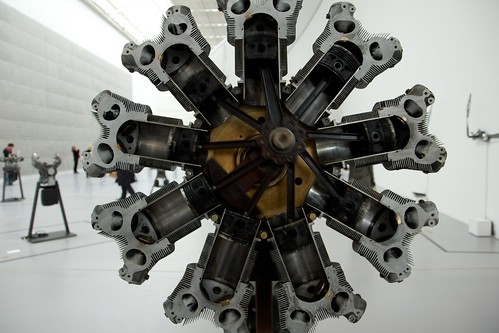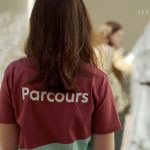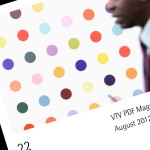One of the largest rooms of dOCUMENTA (13) is dedicated exclusively to the work of German artist Thomas Bayrle. Bayrle, born in 1937 in Berlin, has already participated in Documenta 3 in 1964 and in Documenta 6 in 1977 in Kassel (Germany). Nearly 50 years after his first participation Thomas Bayrle is now celebrating his impressive comeback to one of the most important art events of the world. In this conversation with Dr. Bettina Krogemann, Thomas Bayrle talks about the works he is showing at dOCUMENTA (13). The video above is an excerpt. The interview in full-length is available below.
Framed by two monumental works on the wall, the sounds and movements of 8 kinetic works, draw the visitors into their spell. These sculptures are engines that are cut open. If you ever wanted to know how the motor of a Porsche 911, Moto Guzzi bike or the radial engine of an airplane works: It can be seen here. So the works that Thomas Bayrle presents here are appealing both for art lovers as well as for technology enthusiasts. Bayrle has great respect for the skills of the engineers:
“The engineer is a creative profession that deals with matter in a very real way, much like a doctor. I see this as an incentive, we who make art must strive for precision in our thinking and acting.”
Dr. Bettina Krogemann in conversation with Documenta-artist Thomas Bayrle. Kassel (Germany), June 8, 2012.
> Right-click (Mac: ctrl-click) this link to download Quicktime video file.
Complete interview (12:37 min., in German language with English subtitles):
For Thomas Bayrle the machines are compressed cathedrals, the beauty and complexity of a cathedral in a small space. Bayrle’s kinetic sculptures at dOCUMENTA (13) draw on works he created in 1966, when he built machines. This time, he combines the engines that are cut open with soundtracks that he recorded in a church. He merges the rosary prayer with the engine noise and composes a sound jelly, as he calls it, from their uniform and repetitive sound.
“In fact, I think, in short, rosary prayer and machines belong together. In general: Meditation and machines belong together. It’s the rhythm. Because, our heart has a rhythm, everything we make is serial and the serial sustains us physically, mentally, but also the machines that are actually a reflection of our body.”
Rhythm, repetition, and the aesthetic principle of the serial have always been an essential element of Thomas Bayrle’s work. In the tradition of artists like Andy Warhol, Roy Lichtenstein and Sigmar Polke, Thomas Bayrle draws his motives and themes from the world of goods and the consumer society. Bayrle was trained as a weaver and then studied at the Arts and Crafts School in Offenbach. He learned the technique of lithography and etching. From 1975 to 2005 he was professor at Städelschule, State College of Fine Arts in Frankfurt/Main (Germany). Thomas Bayrle lives in Frankfurt/Main, where he was Professor at the Städelschule (1975-2005). His solo exhibitions have included MACBA, Barcelona (2009), Museum Ludwig, Cologne (2008-09), MMK, Frankfurt/Main (2006), and the Städel Museum, Frankfurt/Main (2002). Bayrle has participated in the Biennale di Venezia (2009, 2003) and documenta 6 and 3 (1977, 1964).







